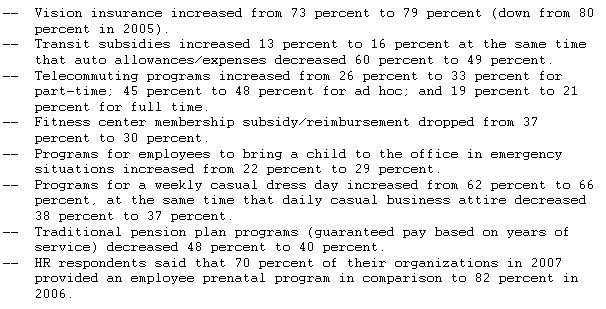The most commonly offered benefits were direct deposit of paychecks, paid holidays, professional development opportunities, payroll deductions, prescription drug program coverage and dental insurance. Additionally, almost all organizations offered some type of health insurance plans.
The SHRM study also noted that with a few exceptions, organizations with larger staff-sizes were more likely than smaller ones to offer any given benefit. HR professionals indicated that their organizations spent an average of 38 percent of payroll on total benefit costs: 20 percent of the costs were due to mandatory benefits and 18 percent due to voluntary benefits.
Automobile allowance/expenses, individual investment advice, traditional defined benefit pension plan, full flexible benefits plan, retirement planning services, employee discount on company services, commission and loans to employees for emergency/disaster assistance all decreased in 2007 from 2006. Cell phone, pager and/or handheld device for personal use was the only financial and compensation benefit that was offered by more organizations in 2007 compared with 2006.
Also, HR respondents indicated they planned within the next year to include pro-active wellness programs in coming benefit packages such as weight loss programs (5 percent), smoking cessation programs (6 percent), health screening programs (5 percent), and health care premium discount for getting an annual health risk assessment (6 percent).
Most benefits remained the same in 2007 from 2006, while others had minor fluctuations. Noteworthy benefit fluctuations from the study follow:

Other survey highlights are:
Overall, 41 percent of HR professionals indicated that their organizations offered some form of domestic partner benefits (opposite-sex partners, same- sex partners or both).
Thirty-eight percent of HR professionals reported that their organizations offered health care benefits for dependent grandchildren, and 29 percent offered health care benefits for foster children.
For the seventh consecutive year, dependent care flexible spending accounts was the most commonly offered family-friendly benefit. More than three out of four HR professionals (76 percent) indicated that their organizations offered dependent care flexible spending accounts to allow employees to set aside pretax dollars that can later be reimbursed for dependent care expenses.





